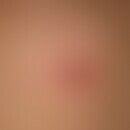DefinitionThis section has been translated automatically.
Not stringently used term for a superficial, purulent, contagious, non follicularly bound, bacterial skin infection caused predominantly by coagulase-positive staphylococci (mostly phage group II, phage type 71) in < 10% by haemolytic group A streptococci (Streptococcus pyogenes). Mixed infections with both pathogens are rarer. The infection preferentially affects children.
ClassificationThis section has been translated automatically.
A distinction is made:
- Non bullous impetigo (Remark: This term is synonymous with contagious small bullous impetigo).
- Bullous impetigo
You might also be interested in
EtiopathogenesisThis section has been translated automatically.
ManifestationThis section has been translated automatically.
HistologyThis section has been translated automatically.
DiagnosisThis section has been translated automatically.
TherapyThis section has been translated automatically.
External therapyThis section has been translated automatically.
Internal therapyThis section has been translated automatically.
ProphylaxisThis section has been translated automatically.
TablesThis section has been translated automatically.
Antibiotic therapy for contagious impetigo
Pathogen |
antibiotic |
Example preparation |
Daily dosages |
Unit |
|||||
Age in years | |||||||||
|
|
|
¼ |
½ |
1 |
3 |
7 ½ |
12 |
|
|
|
|
Average body weight (kg) |
|
|||||
|
|
|
5,5 |
7,5 |
10 |
14 |
24 |
38 |
|
penicillin-sensitive Streptococci (MHK < 0.1 μg/ml) |
Penicillin V |
Isocillin |
0,3 |
0,36 |
0,45 |
0,6 |
0,9 |
1,2 |
million IU |
For penicillin intolerance: Erythromycinethylsuccinate |
Sanasepton forte |
250 |
300 |
375 |
500 |
750 |
1000 |
mg |
|
Staphylococci |
Dicloxacillin |
InfectoStaph |
330 |
400 |
500 |
670 |
1000 |
1330 |
mg |
Flucloxacillin |
Staphylex |
170 |
200 |
250 |
330 |
500 |
670 |
mg |
|
Note(s)This section has been translated automatically.
Incoming links (7)
Acantholysis; Eosinophilic pustular folliculitis; Epidermolysis bullosa junctionalis, generalized severe (historical: Herlitz type); Herpespsis of the newborns; Impetigo, non bullous; Pityriasis amiantacea; Quinolinol sulphate monohydrate solution 0,1 % (nrf 11.127.);Outgoing links (11)
Cephalosporins; Clemastine; Desloratadine; Dimetinden; Folliculitis superficial; Impetiginization; Impetigo contagiosa, large-bubble; Impetigo herpetiformis; Impetigo, non bullous; Pityriasis amiantacea; ... Show allDisclaimer
Please ask your physician for a reliable diagnosis. This website is only meant as a reference.






